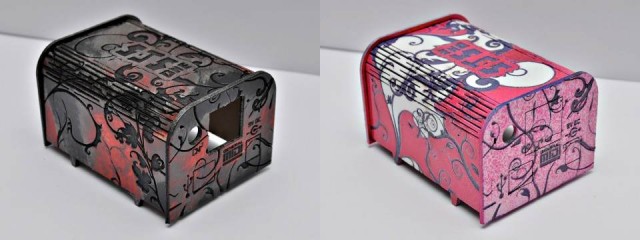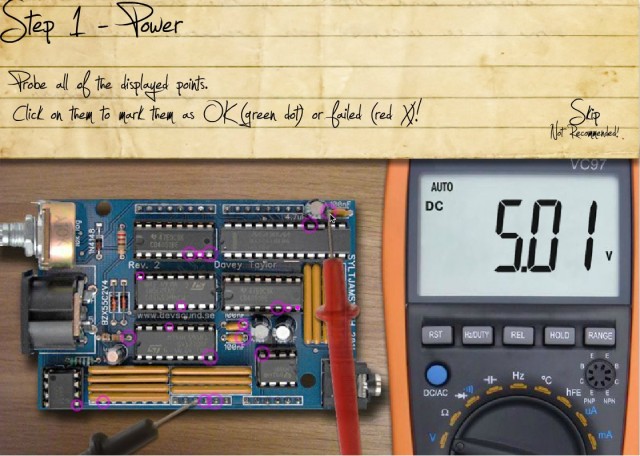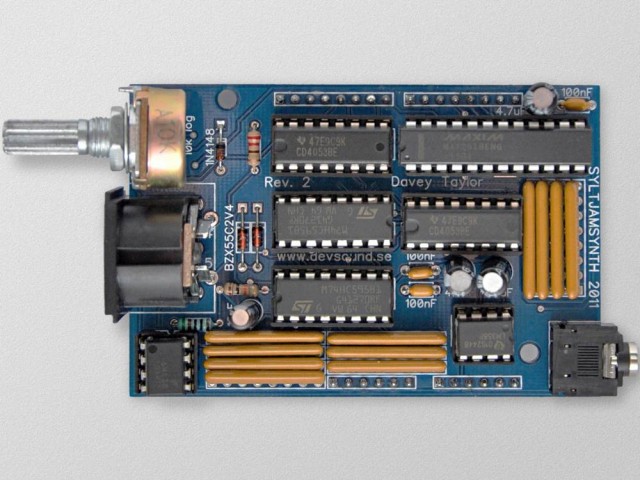SJS-ONE is an 8-bit synth that you add to an Arduino board, making it ideal for hardware and firmware tinkerers and lovers of unique monosynths. But we’ll give it bonus points for two other reasons. First, it has some really bizarre cases available as add-ons, which look a bit like punk birdhouses. (Birdhouse squats? Hot rodded bird tenant buildings?) Second, in a really clever move, they help you troubleshoot hardware issues with a Flash animation. It could make it clear even to a complete beginner how to use a multimeter (a measuring device that checks electrical connections).
The Arduino design is significant, because it makes firmware modification easy for people familiar with that environment. (We’re not letting 2012 end without some tutorials on how to do this with direct AVR programming on our MeeBlip, but I definitely see some appeal to working with Arduino.) To be clear, the way this works is, you can use the Arduino to configure patches on the SJS – so you’re not programming an Arduino synth, directly. You also do need an Arduino Uno in order to use the SJS-ONE.
The real draw to me is the quirky sonic character of the thing. On the sound side, they have a nice approach to the multi-function filter. The whole thing is, indeed, grungy and squelchy. This thing sounds completely mad, defying the typical rules of synth engineering, good behavior, and sound “fidelity.”
Here’s what the developers have to say:
SJS-ONE is a software defined 8-bit mono synthesizer with a dual (series) MAX261, switch-cap filter, which we are, as far as we know, the only ones to use at this point in a DIY-synthesizer. The filter can be programmed to work as low-pass, band-pass, high-pass, all-pass or a combination of filter modes.
The synth works as an Arduino shield, meaning that people can hack and modify the firmware at will. At the moment we have two firmwares finished, one paraphonic, supersaw synth, and one drummachine/sfx synth. More firmwares are in development!
All aspects of the synth can be fully controlled by designing your own custom firmware and we sincerely hope that people will share their firmware in the spirit of the open source and hardware that inspired us to drive this project from idea to final product.
The synthesizer has some interesting history that has certainly colored its development and ultimately its sound. The initial version was developed as an instructional workshop for a synth-event called SyltJam in 2011. The workshop idea was to show people how quickly you can design the basic hardware and software required to produce a platform for versatile audio and music generation.
As it turned out, people liked its sound so much that we decided to refine the design – which more or less involved adding peripheral components to increase configurability and improve on stability and ESD, ground-mismatch and noise sensitivity while keeping the actual design minimal and simplistic.
It’s beginnings are as humble as its production – less than 50 of these have been made available, and all parts are hand-assembled and hand-soldered, while the manual is hand-drawn and cases hand-painted.
Host board: Arduino Uno
ATmega328 16MHz
2KB RAM
32KB Flash ROM
Power supply: USB-B 5V DC
2.1mm center-positive barrel 6-12V DC
Output circuitry: 8-bit R-2R ladder DAC
Filter: MAX261
Analog output: ±2.5V signal level (external amplifier required)
Software defined parameters: Waveform
Filter modes
Filter resonance
Filter cutoff
Filter connection (LP, BP, HP)
Filter bypass
You can purchase the SJS-ONE from the DevSound Shop.
Side note on licensing:
It’s also open source hardware, licensed under a Creative Commons license, with all schematics and code available on GitHub. I should say “open source hardware” in lowercase, because unfortunately, they’ve chosen a non-commercial license. The reason the Open Source Hardware definition requires that that commercial use strings remain out of the license is simple: it’s difficult to define what constitutes a “commercial” project, making confusion for users. It also means incompatibility with projects that work with GPL licenses for software or otherwise comply with open source hardware definitions by eliminating those commercial restrictions.
I can say as a hardware maker with some skin in the game that I strongly encourage use of the ShareAlike restriction. I absolutely understand a desire not to see your work used in a closed project or in a way that doesn’t give back to your effort. But you can use clear branding requirements to avoid confusion between your work and others, and you can use ShareAlike (and software licenses like GPLv3) to ensure that people who do use or modify your project share their work, too.
(If anyone would like to see me do a longer post on licensing, I’m happy to do so!)
it’s a terrific project, though, license quibbles aside. And having some license is still much clearer than the many projects that lack one at all.
Here’s a link to that nice Flash-based troubleshooter:
http://devsound.se/files/SJS1Shooter.swf
“The troubleshooter will show you exactly what you should expect at every single point in the circuit. Note that oscilloscopes may display things slightly different or have different settings from those displayed in the troubleshooter. It may be a good idea to have someone who knows oscilloscopes around to help if you are unsure.
• Steps 1 to 4 can be performed with a multimeter (and any firmware)
• After this you have to download the troubleshooting SyltFirmware and reprogram your SJS-ONE using this sketch.
• Then, for step 5 and onward, you will need an oscilloscope! Sorry, a multimeter just won’t cut it, but if you absolutely can not gain access to an oscilloscope, consider trying something like ZelScope.”
On GitHub: https://github.com/stg/SyltJamSynth2011
Product page: http://devsound.se/products-page/sjs1


